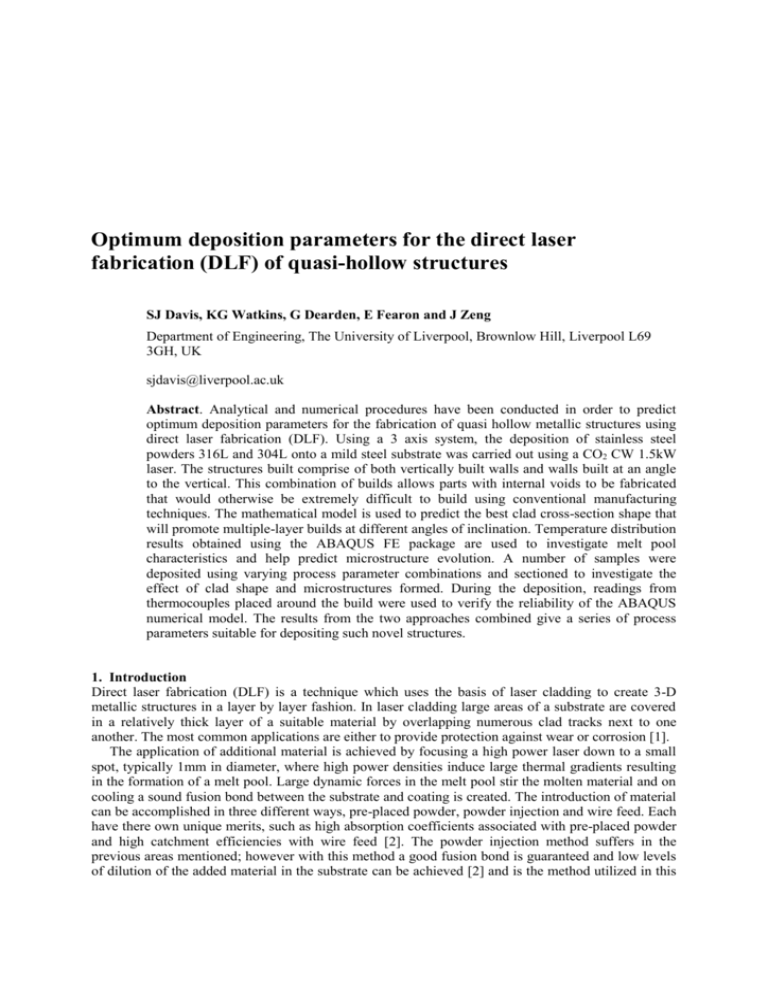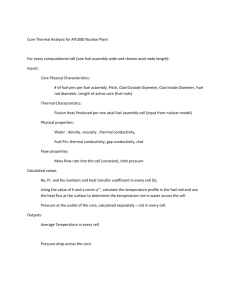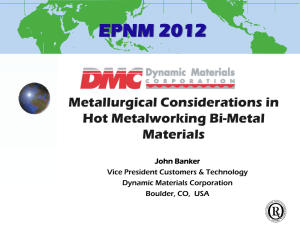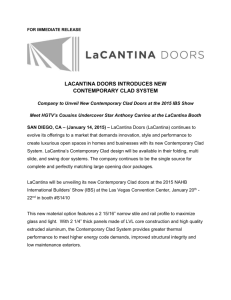of quasi-hollow structures
advertisement

Optimum deposition parameters for the direct laser fabrication (DLF) of quasi-hollow structures SJ Davis, KG Watkins, G Dearden, E Fearon and J Zeng Department of Engineering, The University of Liverpool, Brownlow Hill, Liverpool L69 3GH, UK sjdavis@liverpool.ac.uk Abstract. Analytical and numerical procedures have been conducted in order to predict optimum deposition parameters for the fabrication of quasi hollow metallic structures using direct laser fabrication (DLF). Using a 3 axis system, the deposition of stainless steel powders 316L and 304L onto a mild steel substrate was carried out using a CO2 CW 1.5kW laser. The structures built comprise of both vertically built walls and walls built at an angle to the vertical. This combination of builds allows parts with internal voids to be fabricated that would otherwise be extremely difficult to build using conventional manufacturing techniques. The mathematical model is used to predict the best clad cross-section shape that will promote multiple-layer builds at different angles of inclination. Temperature distribution results obtained using the ABAQUS FE package are used to investigate melt pool characteristics and help predict microstructure evolution. A number of samples were deposited using varying process parameter combinations and sectioned to investigate the effect of clad shape and microstructures formed. During the deposition, readings from thermocouples placed around the build were used to verify the reliability of the ABAQUS numerical model. The results from the two approaches combined give a series of process parameters suitable for depositing such novel structures. 1. Introduction Direct laser fabrication (DLF) is a technique which uses the basis of laser cladding to create 3-D metallic structures in a layer by layer fashion. In laser cladding large areas of a substrate are covered in a relatively thick layer of a suitable material by overlapping numerous clad tracks next to one another. The most common applications are either to provide protection against wear or corrosion [1]. The application of additional material is achieved by focusing a high power laser down to a small spot, typically 1mm in diameter, where high power densities induce large thermal gradients resulting in the formation of a melt pool. Large dynamic forces in the melt pool stir the molten material and on cooling a sound fusion bond between the substrate and coating is created. The introduction of material can be accomplished in three different ways, pre-placed powder, powder injection and wire feed. Each have there own unique merits, such as high absorption coefficients associated with pre-placed powder and high catchment efficiencies with wire feed [2]. The powder injection method suffers in the previous areas mentioned; however with this method a good fusion bond is guaranteed and low levels of dilution of the added material in the substrate can be achieved [2] and is the method utilized in this study. Low dilution is desirable in the process as too deep a melt pool indicates an excess of power and waste of cladding material. In DLF, rather than overlapping, the clad tracks are deposited on top of one another and the fusion bond between these layers allows the fabrication of 3D components with minimal porosity. This technique has been used extensively in rapid prototyping, low volume production and part repair [3] and is sometimes referred to as ‘soft tooling’ as any changes need only be made to the CAD programme. Within this study a mathematical model is utilized to investigate the effect of clad shape factor and type on the degree of unsupported overhang achievable using the DLF process. The numerical model is used to investigate the temperature present during the fabrication of parts having internal voids, termed quasi-hollow parts, with a view to investigating melt pool geometries and help understand microstructure evolution. 2. Mathematical model The model uses the Simpson’s rule to describe the change in clad cross-sectional area with respect to clad height and width. This approach has been used in previous work to aid in predicting melt pool geometry [4] and to optimise clad parameters to avoid excessive dilution and overlap porosity [5]. Here it is being used to help predict the optimum clad shape factor that will promote the deposition of walls built at an incline. It must be noted that, as in previous work, this model assumes that the clad profile is circular, suggesting that surface tension forces are dominant. Using the proposed nozzle system [6], the clad height can be controlled by the step height, which in turn allows more control over the aspect ratio (width/height). The clad type is determined by its height and width, often termed the aspect ratio, and can fall into one of three categories, see figure 1. rb Type 1 Type 2 Type 3 A1 h R A2 Figure 1 Classification of clad type. Figure 2 Schematic of clad cross-section. Figure 2 shows a schematic of the cross-sectional area, A1, of the clad formed on top of the substrate and the accompanying virtual circle created below the substrate A2. Equation 1 below is a well known approximation for a definite integral proposed by Simpson and can be used to calculate half the area of the cross section that lies above the surface. r 2 h2 h2 A1 h 2 rb 4 b 0 2 3 2 4 (1) This model is not valid for values of h greater than rb as the model would then refer to an ellipsoidal clad profile, when in practice a circular cross section profile is maintained. In order to calculate clad areas that have a type 3 clad profiles, the virtual circle created below the substrate is used as this is equivalent to the clad profile formed above the substrate once values of h become greater than rb. The simple geometric model used to calculate this area and is shown below, y 2 x2 R2 R h2 rb 2 R 2 R h 2 (2) And so A2 R 2 A1 (3) rb2 2h Using the above geometric models the clad cross-sectional areas can be calculated in terms of clad height and width. These areas can then be compared to the areas of clad tracks with the same dimensions but having a rectangular cross section, see figure 3. The ratio of the circular cross section compared to that of the rectangular cross section can then be calculated by dividing the former by the latter yielding the clad shape factor S. The variation of S with height is shown in figure 4. 2rb h Figure 3 Ratio of areas that yield clad shape factor. Figure 4 Change in clad shape factor with clad height. Once the values of the clad shape factor had been determined, a series of experiments were then conducted in order to determine the optimum clad shape factor to deposit un-supported overhang builds. 3. Finite Element model The FE package ABAQUS [7] was used to study the thermal history present during the deposition of a section of a quasi-hollow cylinder. The model consists of a 10mm high inner and outer wall, 40mm and 48mm in diameter respectively. A third wall spans from the base of the outer wall and meets at the top of the inner wall forming an incline of approximately 22˚ to the vertical. This structure along with the substrate is shown in Figure 5 and is thought to have potential weight saving advantages in comparison to solid wall cylinders. The application of such components is dependant upon the type of loading and is the subject of another study. For the purpose of this study the model is used purely to investigate the temperatures present in and around the melt pool and how the heat distributed throughout the build may affect microstructure evolution. The main features of the model include a moving heat source, element de-activation and reactivation, heat loss through convection, and nodal temperature history monitoring to be used in conjunction with experimental values obtained from the thermocouple study for the purpose of model validation. The element types used in the model are a 3D transient thermal analysis DC3D8 8-node linear brick. To simulate the deposition of blown powder and incident beam energy, elements that make up the structure are removed initially in the first step and then added individually in subsequent steps with a surface heat flux. Given that the spot size of the laser is 1.4mm and the processing speed is 10mm/s each element has a width of 1.4mm, however the length of each element varies according to its position in the structure, so with this taken into account each element has an individual step time period to accommodate the process speed. A total of five layers were deposited, with a layer height of 2mm, in a fashion identical to the experimental process, and temperature variations in nodes situated approximately in the same position as the thermocouples used in the thermocouple analysis were monitored. It must be noted that the model is conduction limited, and so does not take into account heat transfer due to convection within the melt pool [8]. Affects of latent heat and radiative heat loss are also neglected. Heat loss through surface convection however is accounted for. Figure 5 FE quasi-hollow model. 4. Experimental Using the DLF process described in the introduction, single wall and 3D components were fabricated in order to investigate the affects of process parameters and clad shape on the ability to build at an incline and resulting microstructures were observed. In both studies a 1.5kW CO2 CW laser was used having a TEM01* beam mode. The powder delivery system uses a powder feeder designed by Weerasinghe [9] which feeds down and splits into four side feed delivery nozzle arrangement [6] shown in figure 7. The delivery assist gas is argon and the material used is 304L or 316L stainless steel deposited onto a mild steel substrate. 4.1. Inclined builds To investigate the effects of laser parameters and clad shape factor on building unsupported walls at an incline a series of walls, 50mm long, were deposited at different clad layer heights. To achieve builds at an incline, successive layers were deposited at pre determined offsets (a), starting at 0.1mm and increasing in 0.1mm increments until the build failed, see figure 6. This increase in offset allowed different angles of inclination to be achieved according to the clad height. Laser power ranging from 500 W to 800 W was used in conjunction with powder feed rates of 0.22 g/s to 0.32 g/s and processing speeds of 5mm/s to 10mm/s. The material used was 304L stainless steel. a step Figure 6 Unsupported overhang build. Nozzle arrangement Thermocouple Figure 7 Thermocouple set-up. 4.2. Thermocouple study Cylindrical structures including internal voids, using 304L and 316L stainless steels were deposited. Thermocouples were positioned 10mm away from the process path and at 90˚ to each other, see figure 7. A step height of 1mm was used with the following process parameters; laser power 800W; powder feed rate 0.22 g/s, and process speed 5mm/s. To record the temperature induced during the process, type K welded tip thermocouples were used having a linear temperature range of 270˚C – 1372˚C. The data was recorded using an Agilent 34970 data logger connected to a PC via a RS232 serial cable. 5. Results and Discussion 5.1. Inclined builds Comparisons made between the clad areas determined for rectangular and circular cross-sections produced a variation in clad shape factor, S, shown in Figure 4. For heights of less than 0.7 mm the clad shape factors were in the value range 0.85-0.90. For clad heights equal to 0.7mm and greater it can be seen that S decreases significantly to around 0.72 and then increases again until it levels off at around 0.81. From the deposition of the 50mm long tracks built at an incline it was found that when using clad heights of 0.4mm, inclines to the vertical of around 65˚ could be achieved, whereas clad tracks of height 1mm could only produce 36˚ overhangs. These results suggest that using clad shapes of S equal to and greater than 0.85 should allow larger inclined structures to be built, which in turn means clad Type 2 structures rather than Type 3 should be used to build unsupported overhangs that require large degrees of overhang. 5.2. Thermocouple study The purpose of this study was to validate melt pool temperatures and approximate melt pool depths through comparison of temperatures experienced in the substrate. Comparing the results obtained from experiments and the FE model it is clear that the maximum temperatures experienced in the substrate are much greater for the experimental results, with temperatures reaching as high as 650˚C in the case of the 304L stainless steel and 550˚C for 316L. Maximum temperatures experienced in the model substrate were around 300˚C. However as stated earlier the layer height for the model was 2mm, compare this to the experimental process where the layer height was 1mm, it is clear that the number of passes in the model were half that of the experimental process which will ultimately reduce the accuracy of the model. (b) (a) Figure 8 Thermocouple study for 316 L (a) compared to the FE model for 316L (b). Temperatures in the model experienced in the melt pool were of the order of 3,500˚C and depths were around 2mm. These results suggest that some vaporisation during the process is occurring with high levels of dilution; however these values may not be reliable due to assumptions made earlier, concerning the neglect of latent heat affects and also the model being conduction limited. The accuracy of the model could be further improved by including these factors along with using higher order elements which contain more nodes and hence more integration points. Microstructures found similar to that reported on in [10] were observed. Two types of porosity were noted after inspection using optical microscopy. Porosity due to lack of fusion between layers was the first type observed but only between where the inclined structure left the base of the outer wall and joined the top of the inner wall, Figure 9 (a) and (b) respectively. The second type of porosity was gas porosity which is independent of location and is likely to be as a result of trapped gas stemming from the powder delivery system, figure 9 (c). It is felt that improved accuracy of the FE model is needed in order for it help predict of the evolution of microstructure. (a) (b) (c) Figure 9 Types of porosity observed in quasi-hollow build. 6. Conclusions Overhang angles of approximately 65˚ to the vertical have been deposited using Type 2 clads. This varies from first assumptions that Type 3 clads offered the best shape to deposit steeper inclines. A FE model has is been refined by using readings taken from thermocouples. This will help to predict melt pool temperatures and geometries along with microstructural evolution. Using a laser power of 800W, powder feed rate of 0.22 g/s traverse speed of 5mm/s, produced the largest unsupported overhang. Acknowledgements The author would like to thank Professor William Steen for his help and input on the geometric model and also to David Atkinson for his time and help with the analysis of the component microstructure. References [1] R. Villar.Laser cladding. Journal of laser applications. 11 (1999) 64-79. [2] W.M. Steen. Laser material processing. Third edition. [3] L. Shepeleva et al. Laser cladding of turbine blades. Surface and coatings technology 125 (2000) 45-48. [4] A.J. Pinkerton, L Li. Modelling the geometry of a moving laser melt pool and deposition track via energy and mass balances. Journal of applied physics D: applied physics. 37 (2004) 18851895. [5] R. Colaco, L. Costa, R. Guerra, R. Villar . A simple correlation between the geometry of laser cladding tracks and the process parameters. Laser processing: Surface treatment and film deposition. Ed Mazumder J, Conde O, Villar R, Steen W. Series E: Applied sciences . vol. 307. [6] E. Fearon, K.G. Watkins. 23rd International Congress on Applications of Lasers & ElectroOptics (ICALEO 2004), San Francisco, California, October 4-7, 2004, Paper No. 1708, Laser Institute of America, Publication No 597, Vol. 97, [7] Hibbit, Karlsson and Sorensen, Inc., ABAQUS manual, Pawtucket, RI,USA, 1999. [8] W.M. Steen. Laser surface cladding. Principles of solidification and materials processing. Proceedings of the INDO-US workshop. 1 (1989) 163-178. [9] V.M. Weerasinghe. PhD Thesis, University of Liverpool. 1985. [10] A.C. Costello, et al. Optimisation of laser powder deposition for 316L stainless steel. Proceedings of the 22nd International Congress on Applications of Lasers & Electro-Optics (ICALEO), October 13-16, 2003, Jacksonville, FL., LMP Section E, pp. 144-152.







